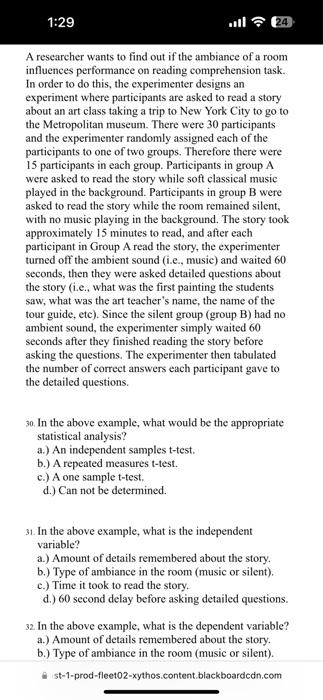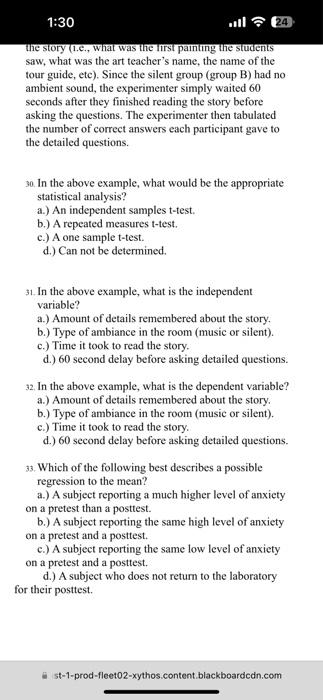A researcher wants to find out if the ambiance of a room influences performance on reading comprehension task. In order to do this, the experimenter designs an experiment where participants are asked to read a story about an art class taking a trip to New York City to go to the Metropolitan museum. There were 30 participants and the experimenter randomly assigned each of the participants to one of two groups. Therefore there were 15 participants in each group. Participants in group A were asked to read the story while soft classical music played in the background. Participants in group B were asked to read the story while the room remained silent, with no music playing in the background. The story took approximately 15 minutes to read, and after each participant in Group A read the story, the experimenter turned off the ambient sound (i.e., music) and waited 60 seconds, then they were asked detailed questions about the story (i.e., what was the first painting the students saw, what was the art teacher's name, the name of the tour guide, etc). Since the silent group (group B) had no ambient sound, the experimenter simply waited 60 seconds after they finished reading the story before asking the questions. The experimenter then tabulated the number of correct answers each participant gave to the detailed questions. 30. In the above example, what would be the appropriate statistical analysis? a.) An independent samples t-test. b.) A repeated measures t-test. c.) A one sample t-test. d.) Can not be determined. 31. In the above example, what is the independent variable? a.) Amount of details remembered about the story. b.) Type of ambiance in the room (music or silent). c.) Time it took to read the story. d.) 60 second delay before asking detailed questions. 32. In the above example, what is the dependent variable? a.) Amount of details remembered about the story. b.) Type of ambiance in the room (music or silent). the story (1.e., what was the first painting the students saw, what was the art teacher's name, the name of the tour guide, etc). Since the silent group (group B) had no ambient sound, the experimenter simply waited 60 seconds after they finished reading the story before asking the questions. The experimenter then tabulated the number of correct answers each participant gave to the detailed questions. 30. In the above example, what would be the appropriate statistical analysis? a.) An independent samples t-test. b.) A repeated measures t-test. c.) A one sample t-test. d.) Can not be determined. 31. In the above example, what is the independent variable? a.) Amount of details remembered about the story. b.) Type of ambiance in the room (music or silent). c.) Time it took to read the story. d.) 60 second delay before asking detailed questions. 32. In the above example, what is the dependent variable? a.) Amount of details remembered about the story. b.) Type of ambiance in the room (music or silent). c.) Time it took to read the story. d.) 60 second delay before asking detailed questions. 33. Which of the following best describes a possible regression to the mean? a.) A subject reporting a much higher level of anxiety on a pretest than a posttest. b.) A subject reporting the same high level of anxiety on a pretest and a posttest. c.) A subject reporting the same low level of anxicty on a pretest and a posttest. d.) A subject who does not retum to the laboratory for their posttest. I. st-1-prod-fleet02-xythos.content.blackboardcdn.com A researcher wants to find out if the ambiance of a room influences performance on reading comprehension task. In order to do this, the experimenter designs an experiment where participants are asked to read a story about an art class taking a trip to New York City to go to the Metropolitan museum. There were 30 participants and the experimenter randomly assigned each of the participants to one of two groups. Therefore there were 15 participants in each group. Participants in group A were asked to read the story while soft classical music played in the background. Participants in group B were asked to read the story while the room remained silent, with no music playing in the background. The story took approximately 15 minutes to read, and after each participant in Group A read the story, the experimenter turned off the ambient sound (i.e., music) and waited 60 seconds, then they were asked detailed questions about the story (i.e., what was the first painting the students saw, what was the art teacher's name, the name of the tour guide, etc). Since the silent group (group B) had no ambient sound, the experimenter simply waited 60 seconds after they finished reading the story before asking the questions. The experimenter then tabulated the number of correct answers each participant gave to the detailed questions. 30. In the above example, what would be the appropriate statistical analysis? a.) An independent samples t-test. b.) A repeated measures t-test. c.) A one sample t-test. d.) Can not be determined. 31. In the above example, what is the independent variable? a.) Amount of details remembered about the story. b.) Type of ambiance in the room (music or silent). c.) Time it took to read the story. d.) 60 second delay before asking detailed questions. 32. In the above example, what is the dependent variable? a.) Amount of details remembered about the story. b.) Type of ambiance in the room (music or silent). the story (1.e., what was the first painting the students saw, what was the art teacher's name, the name of the tour guide, etc). Since the silent group (group B) had no ambient sound, the experimenter simply waited 60 seconds after they finished reading the story before asking the questions. The experimenter then tabulated the number of correct answers each participant gave to the detailed questions. 30. In the above example, what would be the appropriate statistical analysis? a.) An independent samples t-test. b.) A repeated measures t-test. c.) A one sample t-test. d.) Can not be determined. 31. In the above example, what is the independent variable? a.) Amount of details remembered about the story. b.) Type of ambiance in the room (music or silent). c.) Time it took to read the story. d.) 60 second delay before asking detailed questions. 32. In the above example, what is the dependent variable? a.) Amount of details remembered about the story. b.) Type of ambiance in the room (music or silent). c.) Time it took to read the story. d.) 60 second delay before asking detailed questions. 33. Which of the following best describes a possible regression to the mean? a.) A subject reporting a much higher level of anxiety on a pretest than a posttest. b.) A subject reporting the same high level of anxiety on a pretest and a posttest. c.) A subject reporting the same low level of anxicty on a pretest and a posttest. d.) A subject who does not retum to the laboratory for their posttest. I. st-1-prod-fleet02-xythos.content.blackboardcdn.com








